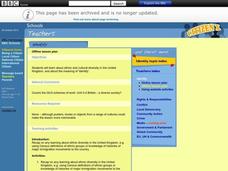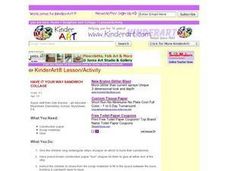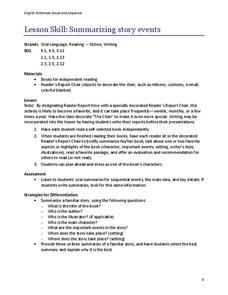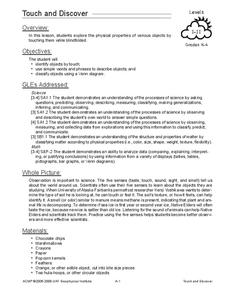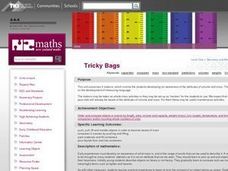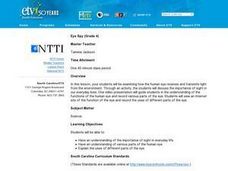Curated OER
Reason for the Seasons
Young scientists examine why we have seasons on Earth, and how the motion of the Earth around the Sun causes them. Groups of learners are given a variety of balls, a bamboo stick, a marker, and a flashlight, then use the objects to...
BBC
Identity
Ethnic diversity is the focus of the political science lesson presented here. In it, pupils discuss the variety of ethnicities they see at their own school. They share their knowledge, or personal experiences of the way that people of...
Curated OER
Have It Your Way Sandwich Collage
You want to make a sandwich out of fabric and paper? If so, this art project provides the instructions needed. Learners will use a variety of fabrics and paper to construct a sandwich through collage. Tip: Have leaners describe the...
Curated OER
Mean / Average
In this mean/average worksheet, learners find the mean in three ways: one, by redrawing the objects in a set to show the mean, two, by adding the numbers and dividing by how many numbers there are and three, by finding the mean with or...
Curated OER
Monster: Compare and Contrast
Helpful for a unit on Walter Dean Myers' Monster, or any novel that you are teaching, a graphic organizer prompts learners to compare and contrast different character traits. The first box has one set of lines to jot down what two...
Curated OER
Summarizing Story Events
Here is a way to build your pupils' public speaking abilities. The lesson plan describes a reader's report chair, which is used each week by a student who has just finished reading a book. The featured reader sits in the chair and talks...
Pennsylvania Department of Education
Shapes Around Us
Learners use manipulatives to study shapes. They sort shapes and use correct geometric terminology to describe them. Students find real-life examples of 2 and 3 dimensional shapes, and classify figures in their classroom according to...
Curated OER
Simple Machines in the Home
Students explore simple machines used in the home. In this simple machines lesson, students discover that many household items are constructed from simple machines. Students interact with nutcrackers, peelers, egg slicers, and egg beaters.
Curated OER
The Plant and Animal Walk
Students draw pictures and write words to describe objects and experiences. They observe outside and draw at least three animals and three plants. Students observe plants and animals describing how they are alike and how they are...
Curated OER
The Same But Different
Fourth graders identify the characteristics of a simple physical change. They describe objects by the properties of the materials from which they are made. Students discuss the different states of matter and their distinct physical...
Curated OER
The Penny Factory
Fourth graders identify the characteristics of a simple physical and chemical change. They describe objects by the properties of the materials from which they are made and separate or sort items using these properties. Students explain...
Curated OER
Physical Properties of Matter
Students examine the physical properties of matter. They identify and classify a variety of objects based on their physical properties.
Curated OER
Mystery Box
Students predict what mystery objects are based on how they feel. In this sense of touch lesson, students reach inside a box and make a guess about the object inside. Once students record their predictions, the objects are revealed....
Curated OER
Touch and Discover
Young scholars identify the physical properties of items using the sense of touch. In this touch and discover lesson, students describe items. Young scholars sort items using a Venn diagram.
Curated OER
Volume and Mass: Identify the Attribute
Students rotate through five studying stations related to the attributes of volume and mass. They manipulate objects to explore mass, compare two masses by pushing and lifting, pack materials and fill containers, and pour liquids from...
Curated OER
Eye Spy!
Students explore using descriptive words by playing a What Do You See? game, describing items in a Mystery Bag, and using Eye-Spy binoculars on an on-campus field trip. They read the book, I Went Walking, and write descriptions of a...
PBS
Looking for Lincoln Throughout His Life
Young historians gather information about Abraham Lincoln through a variety of activities. They match vocabulary words with pictures to create a timeline. Additionally, learners read books and articles that teach them...
Curated OER
Town Mouse/ Country Mouse
Students recognize the difference between the city and the country. In this City Mouse, Country Mouse lesson, students listen to a story and describe and map differences between the city and the country. Students understand that people...
Curated OER
The Five Senses - Magic School Bus
Students identify five senses, draw parts of body that relate to each of the senses, hear different sounds in the environment, write those experiences in their journals, and list at least four objects/things that relate to each of the...
Curated OER
Adjective Riddles
Students create a riddle using adjectives to describe an unknown edible substance to their classmates.
Curated OER
Adjective Riddles
Students create adjective riddles for various candies. They describe the sound, taste, appearance, and smell of the candy, using at least 10 different adjectives. Classmates try to guess the candy name.
Curated OER
Touching Traits
Students describe objects using only their sense of touch. In this lesson on describing characteristics, students use only their sense of touch to describe an unseen object in a box. This lesson can be used an an introduction to plant...
Curated OER
Learning about the World of Color, Object and Shape Patterns
First graders practice identifying and creating patterns by using unifix cubes. In this visual design lesson, 1st graders investigate reoccurring patterns using colors and shapes and extend what is being made with their unifix...
Curated OER
Do Objects Vary Very Much?
Students examine the concept of standard deviation, calculating mean, and collecting data. They measure the standard deviation in a bag of M&M candy, record the data, and calculate the mean.

